Beauty can be different. The 17-year-old blogger has become a star of the social network Instagram, despite her far from perfect skin, reports Smart Magazine.

Hayley Waite is an ordinary teenager. She has been suffering from acne for a long time. However, her face covered with acne made the girl very popular!

Hayley decided that she shouldn’t be ashamed of her natural beauty. She was able to overcome her complexes and become an Instagram star.

Hayley started having skin problems at the age of 11. Almost all teenagers experience acne. It occurs due to improper functioning of the sebaceous glands. The problem can be aggravated by lack of skin care and use of cosmetics.

Hayley was very self-conscious about her facial skin, so she applied a huge amount of foundation and powder to it. Acne caused a lot of problems and troubles. The girl was bullied at school. Because of this, Hayley became withdrawn and rarely left the house.

However, at one point, Waite decided that it was time to change her life. She decided to no longer hide her problem behind tons of “plaster.” The girl created a page on Instagram, where she began publishing photos of herself without foundation and powder.

Hayley thought she would be criticized and made fun of for her face. However, instead, the girl received enormous support, many rave reviews and thousands of subscribers to her Instagram profile.



With her example, Hayley proved that teenagers with acne can no longer be ashamed of their diseased skin. You don't have to give up your usual lifestyle. The main thing is not to spoil your skin even more with tons of cosmetics.
Pimples, which are more delicately called acne, can cause hysterics in any girl, because when you look at all this inflamed darkness, your mood immediately drops below the baseboard. While this is easier for guys, for girls acne is a real mark of the devil, which is very difficult to get rid of. Without noticing it, we can provoke the appearance of acne on our face and in an attempt to get rid of it we only make it worse. Next you will find 5 real stories of girls who were able to get rid of acne, and this is how they did it.
Kali Kushner @myfacestory
Kali Kushner is a 22-year-old student from America who, when looking at her “before” and “after” photos, cannot help but exclaim: “This is amazing!” On her Instagram page, the girl blogs about her skin life, where she tells followers about her journey and struggle with acne.
Since she was a teenager, Kali has been searching for a way to help her achieve clear, healthy skin. But neither pharmacy ointments nor care creams helped her, and sometimes even worsened the situation. After trying many remedies, Kali turned to an isotretinoin-based drug known as Accutane. This is a structural analogue of vitamin A - it helps dissolve fatty plugs that clog pores. In addition, the girl took vitamin C and used a dermaroller. It only took a couple of months, and Kali finally saw improvements in her skin: fewer breakouts, fewer scars, and no more redness.
Currently, Kali has stopped taking Accutane due to side effects: back pain, dryness and dehydration. Now Accutane is no longer available in America, since all the pros and cons of this drug have not been studied.
Molly Greenblatt
Molly suffered from acne for 5 years. Cleansing foams, oils, tonics - nothing helped against the hated acne. The girl even resorted to a remedy similar in properties to the drug that Kali Kushner took, but it did not bring her long-term results. Then Molly decided to take a more radical step - stop washing her face.
Of course, Molly did not avoid getting water on her face: she calmly took a shower or bath, but did not use any special cleansers. Sticking to the plan, a year later the girl saw cleaner and smoother skin in the mirror: the rashes had almost disappeared, and her complexion had improved.
Rachel Crowley @asprinkleofhealthandbeauty
Since childhood, Rachel suffered from ridicule from peers who mocked her because of her acne. She grew up as an insecure girl, embarrassed by her skin and did her best to hide the rashes on her face under a ton of makeup. At the age of 18, Rachel had the opportunity to participate in a local beauty pageant, but she refused to participate, being too insecure due to her acne. This moment became a turning point in Rachel’s fate - she decided that it was time to get rid of acne once and for all and show everyone what she was capable of.
The girl decided to conduct an experiment with her diet, gradually eliminating one product at a time from her usual menu. Imagine her surprise when it turned out that the main enemy for her skin was sugar and fast carbohydrates: “I didn’t eat these foods for just three days and increased my consumption of saturated fats. And guess what? No new breakouts!”
Now the girl adheres to a vegan diet, which involves the consumption of thermally unprocessed foods. Rachel says don't be afraid to cut sugar out of your diet for a while. In her opinion, it is the excessive consumption of sweets that can negatively affect the skin.
Anna Zelentsova @zelencanna
This girl's story is somewhat different from others. Anna was never genetically predisposed to acne - even as a teenager, her skin remained clear and well-groomed. However, over time, skin rashes overtook her too. The girl turned to dermatologists and looked for information on forums on the Internet. But the treatment prescribed by the doctor only made the problem worse. However, Anna did not despair and did not take her situation for granted, but continued to fight the hated acne, but in other ways.
Anna reviewed her diet, eliminating milk, pure sugar and sweets with a chemical composition, such as store-bought marmalade and chewing candies. In addition, the girl took a course of antibiotics, which are prescribed to people with a certain degree of acne. Anna also started taking vitamins and healthy fats Omega-3 and Omega-6 in capsules. Thanks to an integrated approach to the problem, the girl was able to overcome acne in just a few months! And although Anna herself followed somewhat alternative methods of dealing with acne, she advises her subscribers to first of all contact competent doctors.
Miroslava Zhemchugova mira_slava91
In the fight against acne, blogger Miroslava Zhemchugova resorted to gentle peelings, deep cleansing, and laser treatments, but in the end nothing saved her from rashes on her face, back and shoulders. The more the girl tried, the more her skin condition worsened. Even doctors and dermatologists seemed unable to help. But Miroslava did not despair and decided to cure her skin on her own. The result is obvious!
Miroslava believes that the scientific approach has not been canceled: having studied a sufficient amount of research and work on the topic of skin diseases, it is quite easy to defeat acne. Miroslava recommends visiting the online platform International Alliance of Dermatologists, where you can find all the necessary information. For prevention, the girl advises taking a complex of vitamins A, E, C and zinc capsules - a building material for our skin and the body as a whole. She is convinced that everyone should be able to understand the problem on their own, but notes that it is very important to find a good specialist.
From this article you will learn:
- acne on the face: causes of appearance,
- acne on the face - photo, how they differ from acne,
- acne - treatment.
Facial acne is a disease in which plugs consisting of sebum and desquamated skin cells form in the skin pores. The disease is usually called by the terms: acne or acne, and acne itself is often called acne vulgaris or comedones.
Acne is usually divided into two types –
- Closed acne (Fig. 1-3) –
they are white in color and look like white bumps on the surface of the skin. The plugs inside them are not visible.
- Open acne (Fig. 4-6) –
plugs are clearly visible inside the pores, because are black. The dark color of corks is not caused by dirt, as is commonly believed, but by the skin pigment melanin.
Acne: photo

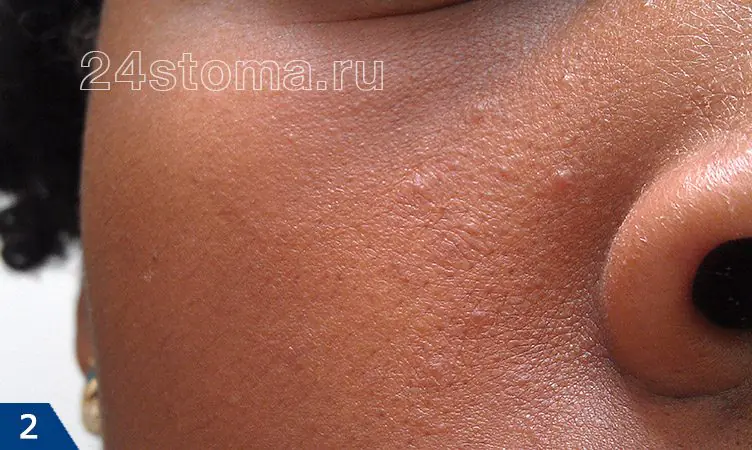
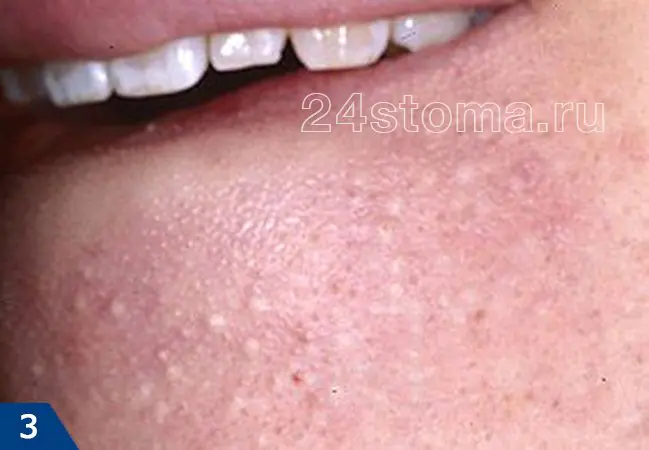
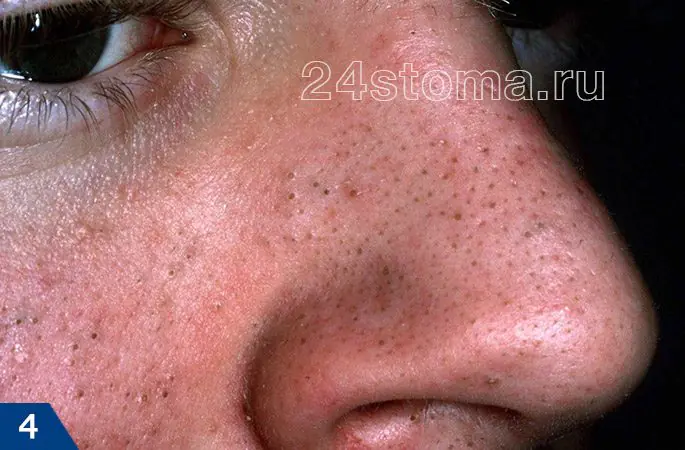

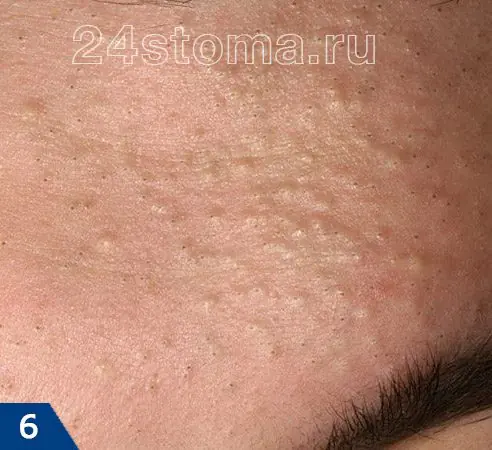
Almost all people have acne on their nose. Acne on the forehead, chin, and cheeks is quite common.
In many articles, incompetent authors often call acne vulgaris - pimples. Although acne and pimples are completely different things, which are even treated differently... With acne, there are fat plugs in the skin pores, with a complete absence of inflammation inside and around them. 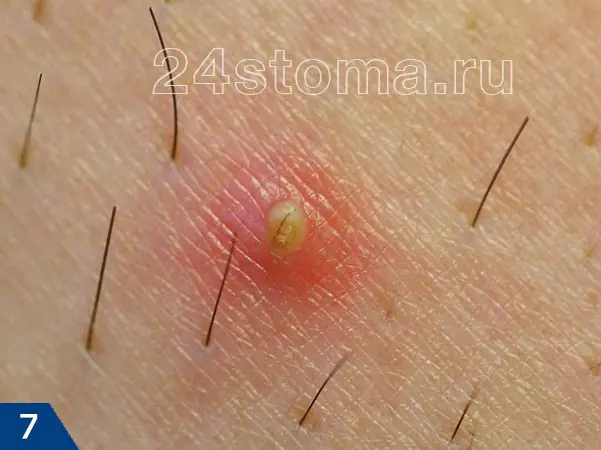
A pimple is a hair follicle that has already festered under a plug, around which inflammation develops (Fig. 7).
In dermatology there is also the term Acne. This term combines both acne and pimples, and also includes the consequences of the healing of large pimples and cysts - scars and age spots.
Acne on the face: causes of formation
Hair follicles and the sebaceous glands located around them take part in the formation of acne. From such follicles hairs grow on the face, penetrating the surface of the skin through the skin pores (Fig. 8a). The sebaceous glands, in turn, produce sebum, which penetrates through ducts first into the lumen of the hair follicle, and then through the pores onto the surface of the skin.
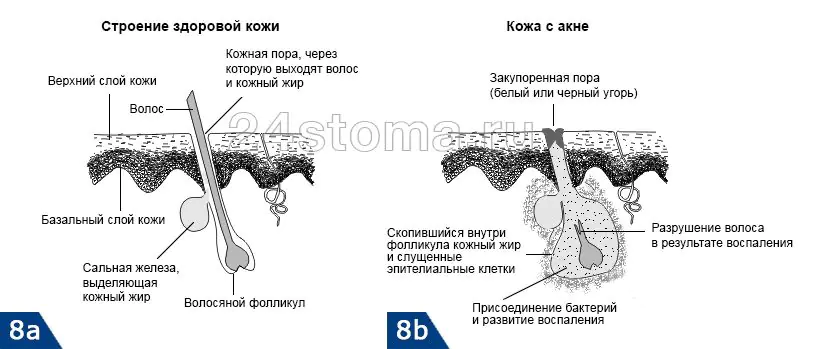
The appearance of acne is associated with 2 main factors:
- Increasing the production of sebum by the sebaceous glands -
it usually occurs in adolescents during puberty. During this period, the amount of hormones (androgens) in the blood increases, which are produced both in men and in smaller quantities in women. Androgens tend to enhance the function of the sebaceous glands.
- Keratosis of the epithelium of the hair follicle -
The inner walls of all hair follicles are covered with epithelial cells. These cells, like any other cells on the surface of the skin and mucous membranes, are gradually exfoliated, and new ones appear in their place. A disruption in the rate of keratinization of epithelial cells (called keratosis) leads to an increase in the number of exfoliated dead cells in the lumen of the follicle.
As a result of these two processes, skin pores become clogged with plugs consisting of sebum and desquamated epithelial cells. Moreover, the sebaceous glands still continue to produce sebum. But due to the plugs, it can no longer reach the surface of the skin and accumulates in the lumen of the hair follicle, stretching its walls (Fig. 8b).
If such plugs form deep in the skin pore (closer to the hair follicle), then closed whiteheads appear (Fig. 9,1,2,3). If plugs form in the upper part of the skin pores, then open blackheads with black heads are formed (Fig. 10,4,5,6).
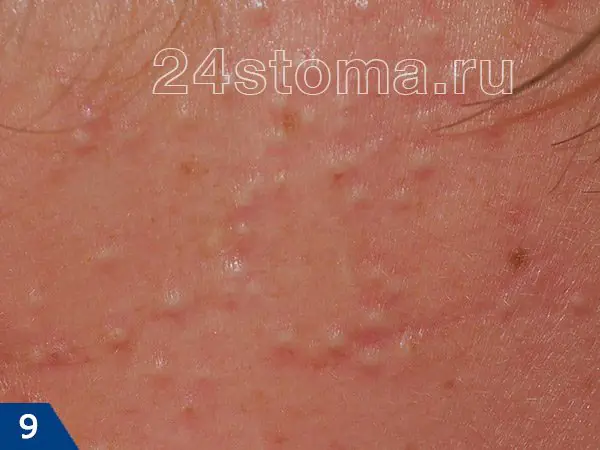

How acne forms from acne –
If bacteria brought from the surface of the skin are inside the clogged hair follicle, inflammation develops, which consists of the formation of pus inside the follicle. This is a real pimple (Fig. 7), and not an acne.
You will find more information on the treatment of acne in our article:
→ “All about acne treatment”
Acne on the face: predisposing factors
The main reason for acne is the increased production of androgens during puberty. However, this is not the only factor that contributes to the appearance of acne. Predisposing factors are also:
- Fat-based cosmetics –
Skin care products and cosmetics can cause acne if they are oil-based. For the face, it is advisable to use products that are water-based (such products do not clog skin pores).
- Birth control pills and hormonal changes –
Women may experience a regular exacerbation of acne once a month, associated with hormonal changes in the premenstrual period. Birth control pills can only stimulate acne if the pill contains only pure progesterone.
- Medications -
If you are taking anticonvulsants, bromides, lithium, iodides, prednisolone or its analogues, as well as steroid hormones (usually taken by athletes), keep in mind that they can stimulate the appearance of acne. - Increased sweating -
If, due to physiology or due to increased physical activity or work conditions, you often sweat, this can aggravate your acne.
Acne: treatment at home
How to get rid of acne?... The most difficult thing in treating acne is making the right choice of preparations for treating facial skin. Anti-acne products are sold in pharmacies and on the Internet in huge quantities. Moreover, many of them are practically ineffective, and only a dermatologist or cosmetologist can correctly evaluate and select drugs for treatment.
- It is better to start treatment of acne in adolescents as early as possible, because... in this case, it is possible to prevent the transformation of acne into pimples, after which scars and age spots remain on the skin.
- Treatment of acne in women is carried out in the same way as for other groups of patients (you will see basic therapy below). If the effect of basic therapy is insufficient, birth control pills or spironolactone may be prescribed.
Acne treatment regimen –
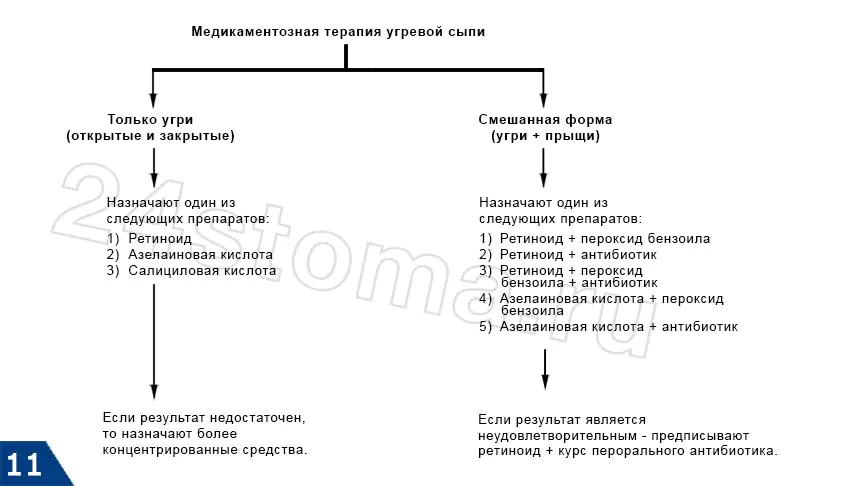
Below you can familiarize yourself in detail with the groups of drugs outlined in the scheme.
1. Retinoids –
Preparations of the Retinoid group belong to vitamin A derivatives. And this is probably the best remedy for acne. The use of retinoids helps remove existing plugs (blackheads) from the skin pores, and also helps prevent the appearance of new acne. The highest effectiveness is with retinoids in the form of lotions; Gels are slightly inferior to them, and creams are the least effective.
Modern retinoid drugs are made on the basis of Tretinoin, Adapalene or Tazarotene. Keep in mind that preparations with retinoids can be either single-component or combined. Monocomponent retinoids are used when there is acne on the skin (without acne), and combined retinoids are used when there is a mixed form, i.e. when the skin has both blackheads and pimples.
Monocomponent retinoids -
1) with tretinoin: Retin-A (USA), Lokacid (France) and Airol (Switzerland)
2) with adapalene: Differin (France), Clenzit (India), Deriva (India)
3) based on tazarotene: Zorak (Germany), Tazret-gel (India).
Combined drugs -
Retinoids are usually combined with either an antibiotic or benzoyl peroxide. These components are very effective when, in addition to acne, there are inflamed pimples on the skin.
1) “Epiduo” (France), “Effezel” (France) – retinoid Adapalene + benzoyl peroxide,
2) “Deriva-S”, “Klenzit-S” - contain Adapalene + the antibiotic clindamycin.

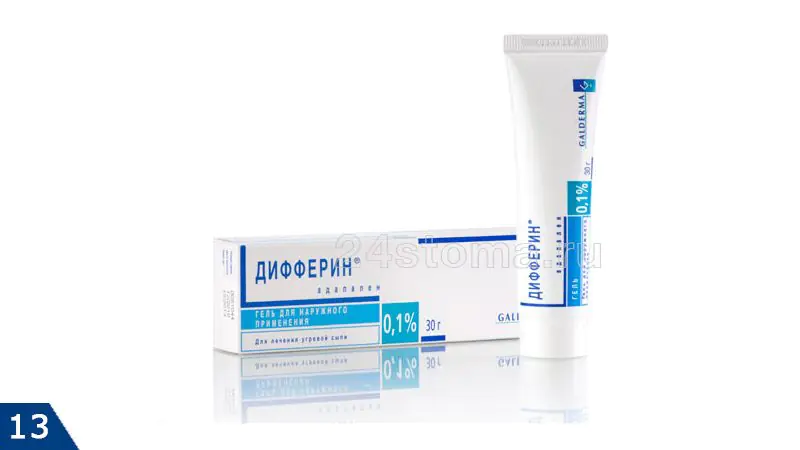
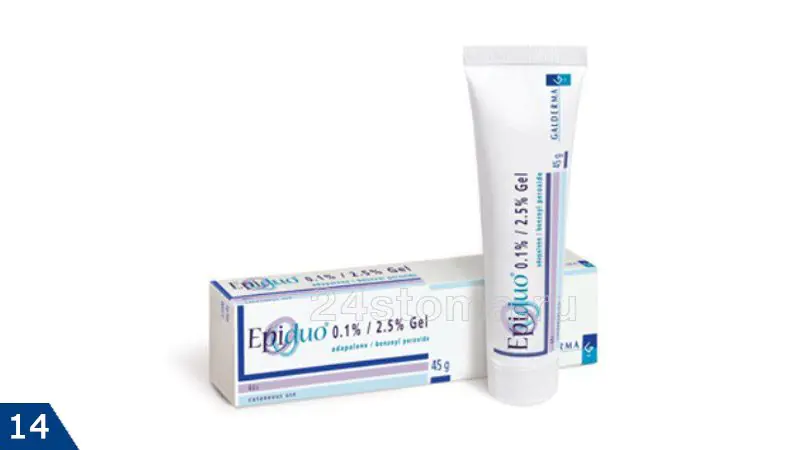
Application scheme –
Retinoids are used only once a day (at night) - 20 minutes after washing your face with a mild cleanser. The course of treatment is at least 3 months, but you will see a good result within 5-6 weeks. You need to start using the drug 3 times a week, gradually moving to daily use. In this case, the skin will not be very irritated and will quickly get used to it.
- slight burning or skin irritation may occur,
- retinoids should not be used together with peeling products (significant skin irritation is possible),
- increased skin sensitivity to the sun (be sure to use sun protection on sunny days).
2. Azelaic acid –
Preparations based on azelaic acid exfoliate dead layers of skin, helping to remove traffic jams, and also have an antibacterial effect. For acne, azelaic acid is prescribed as an independent treatment, and for acne with pimples - as an addition to benzoyl peroxide or antibiotic gel.
For oily skin it is better to use gels, and for dry skin - creams with azelaic acid. Examples of drugs: Skinoren (Germany), Azix-derm (India), Azogel (Russia), Acne-derma (Poland).
Features of application –
The drug is applied 2 times a day to areas of the skin that have acne. The effect will be noticeable within 1 month from the start of treatment. The course of treatment is at least 3 months. The positive features of azelaic acid are that it does not increase skin sensitivity to the sun, prevents the appearance of age spots, and also causes less skin irritation.
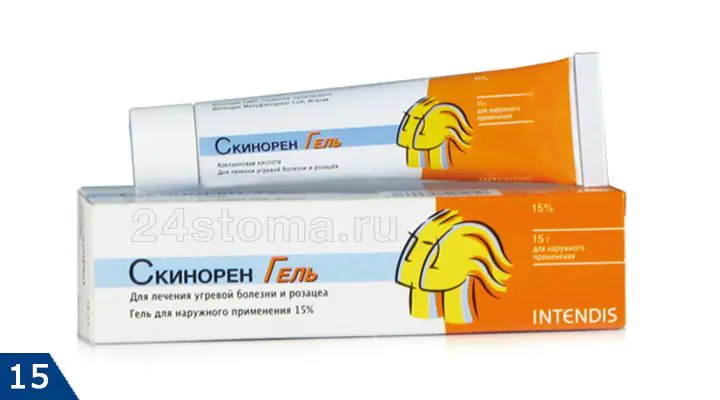
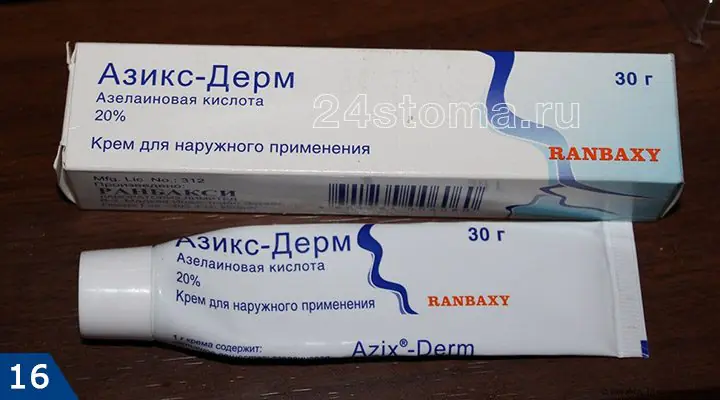
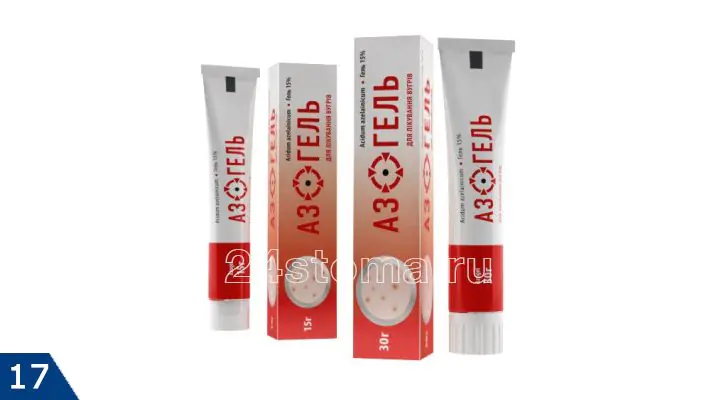
3. Salicylic acid –
Acetylsalicylic acid has the property of dissolving the fatty substrate that makes up acne, as well as exfoliating dead skin cells. Acne preparations based on salicylic acid come in 0.5% or 2% concentrations, both in the form of lotions and gels. An example is the “Clearasil” line of products in the form of lotion, cream and gel.
For acne, salicylic acid has a good effect, but it is still at least 2 times lower than from the use of retinoids. But the use of salicylic acid not for acne, but for pimples, is generally ineffective and simply makes no sense.
Features of application –
Be prepared for the fact that if you regularly use products with salicylic acid, your skin will become red and flaky. If you have dark skin, keep in mind that salicylic acid, when used regularly, will cause pigment spots to appear on the skin.
4. Treatment of acne with antibiotics -
Treatment of acne with antibiotics cannot be effective because acne is not an inflammatory or infected formation. An acne is a pore clogged with sebum, in the depths of which sebum secreted by the sebaceous glands accumulates. Therefore, antibiotics are not used for acne, but for acne, on the contrary, this is one of the main types of treatment.
Summary -
Above we have listed an exhaustive list of drugs that are used specifically for acne. If the result of treatment with these drugs was insufficient, then similar drugs with higher concentrations of active elements are selected.
Important: if you have not only acne, but also pimples at the same time -
in this case, in addition to retinoids and azelaic acid, the following groups of drugs are used:
- gels, lotions and creams with benzoyl peroxide (very effective!),
- or antibiotics in the form of gels for topical use.
You can find out about the properties and brands of these drugs in the article: “Drugs for the treatment of acne”
Three additional rules for treating acne at home -
In addition to the basic treatment with retinoids, azelaic or salicylic acids, you must always follow three important rules...
Regular cleansing and skin care –Wash your face twice a day only with mild cleansers (such as Neutrogena). This will keep your skin clean and minimize irritation. You also need to avoid using oil-based cosmetics and skin care products (they clog pores). Use water-based products only!
Mild peeling preparations can be used periodically. You can do this peeling even at home, but you just need to use professional products for home use, but not soda, aspirin or lemon. Such products most often contain glycolic acid, which exfoliates dead surface skin cells, which also helps open pores.

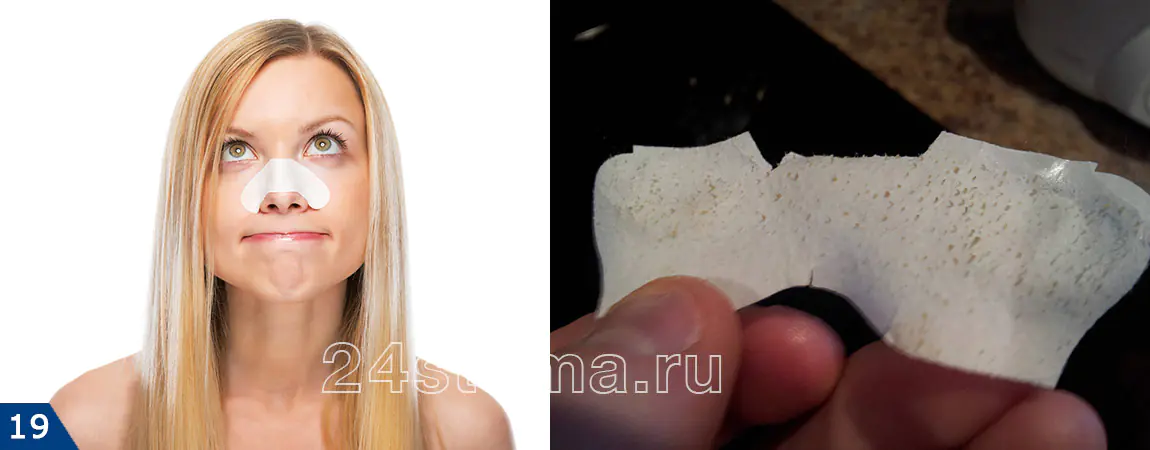
To reduce the amount of sebum inside and on the surface of the skin, as well as oily skin, use the following products:
→ special toners for cleansing oily skin,
→ special cosmetic strips (Fig. 19), which are attached to the surface of the skin on the nose, forehead, cheeks or chin to remove sebum from the pores (Nivea, “Propeller”, etc.).
→ special cosmetic masks will help draw out sebum from the skin.
If you only have acne, then you do not need to use these products. However, if acne periodically turns into pimples, then you can use benzoyl peroxide-based bactericides (once every 2 days) to prevent the appearance of pimples.
Is it possible to squeeze out blackheads?
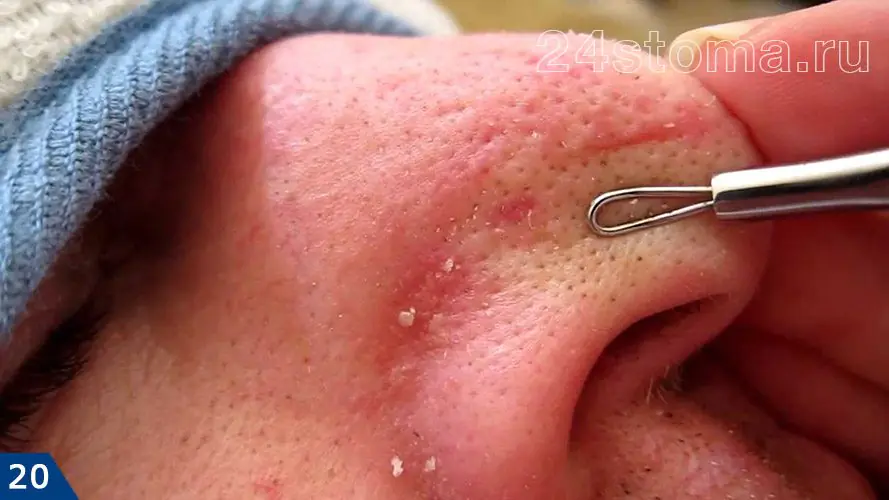
You need to make sure to keep your hands away from blackheads. This is due to the fact that squeezing out acne can: firstly, lead to deep infection and the development of purulent pimples, and secondly, in some cases, when compressed (especially closed acne), the membrane in which the sebaceous gland fat is located ruptures.
This leads to sebaceous gland fat not reaching the surface of the skin, but deep into the soft tissues, which will cause inflammation in the deep layers of the skin and suppuration. It is best to use special strips and treatment masks designed to extract sebum from the pores.
But in some cases, dermatologists and cosmetologists still recommend acne removal. This is done using special tools “comedone extractors” (Fig. 20 and video).
Squeezing out blackheads: video
We hope that our article on the topic: How to remove acne from your face was useful to you!



